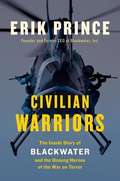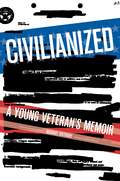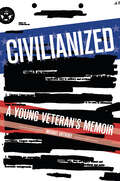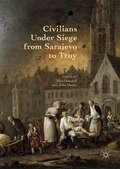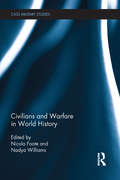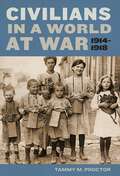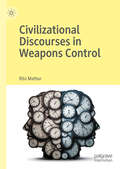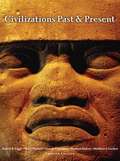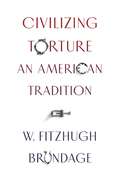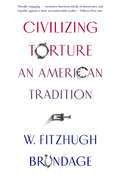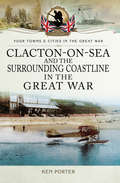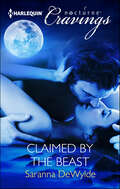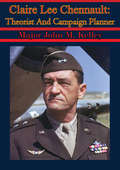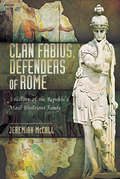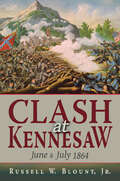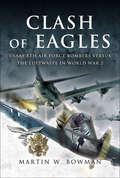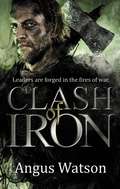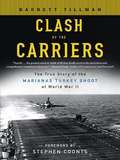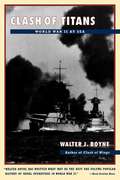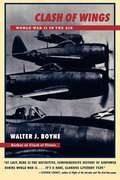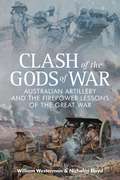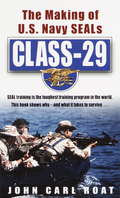- Table View
- List View
Civilian Warriors: The Inside Story of Blackwater and the Unsung Heroes of the War on Terror
by Erik PrinceNo company in our time has been as mysterious or as controversial as Blackwater. Founded by former Navy SEAL Erik Prince in 1997, it recruited special forces veterans and others with the skills and courage to take on the riskiest security jobs in the world. As its reputation grew, government demand for its services escalated, and Blackwater's men eventually completed nearly one hundred thousand missions in Iraq and Afghanistan. Both the Bush and Obama administrations found the company indispensible. It sounds like a classic startup success story, except for one problem: Blackwater has been demonized around the world. From uninformed news coverage to grossly distorted fictional portrayals, Blackwater employees have been smeared as mercenaries, profiteers, jackbooted thugs, and worse. Because of the secrecy requirements of Blackwater's contracts with the Pentagon, the State Department, and the CIA, Prince was unable to speak out when his company's opponents spread false information. But now he's able to tell the full and often shocking story of Blackwater's rise and fall. In Civilian Warriors, Prince pulls no punches and spares no details. He explains his original goal of building an elite center for military and law enforcement training. He recounts how the company shifted gears after 9/11. He honors our troops while challenging the Pentagon's top leadership. And he reveals why highly efficient private military contractors have been essential to running our armed forces, since long before Blackwater came along. Above all, Prince debunks myths about Blackwater that spread while he was forced to remain silent-myths that tarnished the memory of men who gave their lives for their country but never got the recognition they deserved. He reveals new information about some of the biggest controversies of the War on Terror, including: • The true story of the Nisour Square massacre in Baghdad. • The actual details of Blackwater's so-called impunity in Iraq. • The events leading up to the televised deaths of Blackwater contractors in Fallujah. Prince doesn't pretend to be perfect, and he doesn't hide the sometimes painful details of his private life. But he has done a great public service by setting the record straight. His book reads like a thriller but is too improbable to be fiction.From the Hardcover edition.
Civilianized: A Young Veteran's Memoir
by Michael AnthonyAfter 12 months of military service in Iraq, Michael Anthony stepped off a plane, seemingly happy to be home--or at least back on US soil. He was 21 years old, a bit of a nerd, and carrying a pack of cigarettes that he thought would be his last. Two months later, Michael was stoned on Vicodin, drinking way too much, and picking a fight with a very large Hell's Angel. At his wit's end, he came to an agreement with himself: If things didn't improve in three months, he was going to kill himself. Civilianized is a memoir chronicling Michael's search for meaning in a suddenly destabilized world.
Civilianized: A Young Veteran's Memoir
by Michael AnthonyAfter twelve months of military service in Iraq, Michael Anthony stepped off a plane, seemingly happy to be home—or at least back on US soil. He was twenty-one years old, a bit of a nerd, and carrying a pack of cigarettes that he thought would be his last. Two weeks later, Michael was stoned on Vicodin, drinking way too much, and picking a fight with a very large Hell's Angel. At his wit's end, he came to an agreement with himself: If things didn't improve in three months, he was going to kill himself. Civilianized is a memoir chronicling Michael's search for meaning in a suddenly destabilized world.
Civilians Under Siege from Sarajevo to Troy
by John Horne Alex DowdallThis edited volume analyses siege warfare as a discrete type of military engagement, in the face of which civilians are particularly vulnerable. Siege warfare is a form of combat that has usually had devastating effects on civilian populations. From the near-contemporary Siege of Sarajevo to the real and mythical sieges of the ancient Mediterranean, this has been a recurring type of military engagement which, through bombardment, starvation, disease and massacre, places non-combatants at the heart of battle. To date, however, there has been little recognition of the effects of siege warfare on civilians. This edited volume addresses this gap. Using a distinctive regressive method, it begins with the present and works backwards, avoiding teleological interpretations that suggest the targeting of civilians in war is a modern phenomenon. Its contributors interrogate civilians' roles during sieges, both as victims and active participants; the laws and customs of siege warfare; its place in historical memory, and the ways civilian survivors have dealt with trauma. Its scope and content ensure that the collection is essential reading for all those interested in the place of civilians in war. Chapter 2 of this book is available open access under a CC BY 4. 0 license at link. springer. com
Civilians and Warfare in World History (Cass Military Studies)
by Nicola Foote Nadya WilliamsThis book explores the role played by civilians in shaping the outcomes of military combat across time and place. This volume explores the contributions civilians have made to warfare in case studies that range from ancient Europe to contemporary Africa and Latin America. Building on philosophical and legal scholarship, it explores the blurred boundary between combatant and civilian in different historical contexts and examines how the absence of clear demarcations shapes civilian strategic positioning and impacts civilian vulnerability to military targeting and massacre. The book argues that engagement with the blurred boundaries between combatant and non-combatant both advance the key analytical questions that underpin the historical literature on civilians and underline the centrality of civilians to a full understanding of warfare. The volume provides new insight into why civilian death and suffering has been so common, despite widespread beliefs embedded in legal and military codes across time and place that killing civilians is wrong. Ultimately, the case studies in the book show that civilians, while always victims of war, were nevertheless often able to become empowered agents in defending their own lives, and impacting the outcomes of wars. By highlighting civilian military agency and broadening the sense of which actors affect strategic outcomes, the book also contributes to a richer understanding of war itself. This book will be of much interest to students of military studies, international history, international relations and war and conflict studies.
Civilians in a World at War, 1914-1918
by Tammy M. ProctorWorld War I heralded a new global era of warfare, consolidating and expanding changes that had been building throughout the previous century, while also instituting new notions of war. The 1914-18 conflict witnessed the first aerial bombing of civilian populations, the first widespread concentration camps for the internment of enemy alien civilians, and an unprecedented use of civilian labor and resources for the war effort. Humanitarian relief programs for civilians became a common feature of modern society, while food became as significant as weaponry in the fight to win.Tammy M. Proctor argues that it was World War I—the first modern, global war—that witnessed the invention of both the modern “civilian” and the “home front,” where a totalizing war strategy pitted industrial nations and their citizenries against each other. Civilians in a World at War, 1914-1918, explores the different ways civilians work and function in a war situation, and broadens our understanding of the civilian to encompass munitions workers, nurses, laundresses, refugees, aid workers, and children who lived and worked in occupied zones, on home and battle fronts, and in the spaces in between. Comprehensive and global in scope, spanning the Eastern, Western, Italian, East African, and Mediterranean fronts, Proctor examines in lucid and evocative detail the role of experts in the war, the use of forced labor, and the experiences of children in the combatant countries.As in many wars, civilians on both sides of WWI were affected, and vast displacements of the populations shaped the contemporary world in countless ways, redrawing boundaries and creating or reviving lines of ethnic conflict. Exploring primary source materials and secondary studies of combatant and neutral nations, while synthesizing French, German, Dutch, and English language sources, Proctor transcends the artificial boundaries of national histories and the exclusive focus on soldiers. Instead she tells the fascinating and long-buried story of the civilian in the Great War, allowing voices from the period to speak for themselves.
Civilizational Discourses in Weapons Control
by Ritu MathurThis book seeks to decolonize practices of arms control and disarmament. In this endeavor it seeks to problematize our understanding of time and civilization as rhetorical resources. The need for such an undertaking can be premised on the claim that while problems of modernity, ethnocentrism and universalism are now a central concern within the field of international relations, these ideas are scarcely debated or contested within the field of arms control and disarmament. The singular focus on technological innovations and specific policy-oriented agreements in practices of arms control and disarmament appears to stymie the need for such engagements. This book is an invitation to explore intersecting discourses on colonialism, racialism, nationalism and humanitarianism within a historically grounded terrain of weapons control. An understanding of these practices is vital not to prescribe any standards of civilization or exceptionalism in weapons control but to be cognizant through critique of the dangers embedded in any effort at reconstellating the constitutional nuclear order.
Civilizations Past & Present, Combined Volume, Twelfth-Edition
by Barbara Molony Neil J. Hackett George F. Jewsbury Robert R. Edgar Matthew S. GordonThe twelfth edition of Civilizations Past & Present continues to present a survey of world history, treating the development and growth of civilization as a global phenomenon involving the interaction of all of the world's cultures. This new edition, like its predecessors, includes all the elements of history--social, economic, political, military, religious, aesthetic, legal, and technological--to illustrate this global interaction.
Civilizing Torture: An American Tradition
by W. Fitzhugh BrundageOver the centuries Americans have turned to torture during moments of crisis, and have debated its legitimacy and efficacy in defense of law and order. Tracing these historical attempts to adapt torture to democratic values, Fitzhugh Brundage reveals the recurring struggle over what limits Americans are willing to impose on the power of the state.
Civilizing Torture: An American Tradition
by W. Fitzhugh BrundageOver the centuries Americans have turned to torture during moments of crisis, and have debated its legitimacy and efficacy in defense of law and order. Tracing these historical attempts to adapt torture to democratic values, Fitzhugh Brundage reveals the recurring struggle over what limits Americans are willing to impose on the power of the state.
Clacton-on-Sea and the Surrounding Coastline in the Great War (Your Towns & Cities in the Great War)
by Ken PorterClacton-on-Sea and the surrounding coastline is part of the Sunshine Coast, an area of sandy beaches and low-level cliffs facing the North Sea. This book gives a brief history of the major nearby villages Brightlingsea, St Oysths, Clacton on Sea, Holland on Sea, Frinton and Walton on the Naze as they developed from agricultural areas, to seaside resorts in the mid to late 1800s, and then into heavily defended hives of activity. They were considered by the authorities to be convenient spots for foreign invasion and, as a result, mock invasion exercises at Clacton had taken place since the early 1900s. Being close to the sea, many of the inhabitants were heavily involved with yachting and the Royal National Lifeboat Institution, so it's not surprising that a great number joined the Royal or Merchant Navy.Brightlingsea became a major naval port and the Australian and New Zealander's Engineers trained there for four years. Clacton itself saw over a 1,000 men sign up, and it also had a number of Military and Convalescent Homes that treated injured men. Middlesex Hospital, for one, treated over 9,000 men. The local villages produced a considerable number of men who were awarded the Military Medal/Cross, and Walton on the Naze produced one VC in Herbert Columbine.The tremendous efforts of others are also covered, in particular those of the local women folk. A number of appropriate poems, many written at the time, are included throughout the book, as well as rarely seen photographs and insightful reports from the local papers of that period.
Claimed by the Beast
by Saranna DeWyldeDr. Daphne Panetta is desperate to find a cure for a virus that turns its victims into zombie werewolves. Infected Konstantin Gevaudan should be nothing more than a test subject, but the only thing Daphne fears more than the beast within him is her own intense attraction to the virile man himself....When the research facility where he's being held goes up in flames, Konstantin has no choice but to take Daphne on the run with him. For the desire burning between them can mean only one thing: she is his true mate. But how can he claim her without changing her-forever?
Claimed by the Wolf
by Saranna DeWyldeGyspy prince Stefan Zolinski has been raised to hunt down and eliminate werewolves like the one that killed his mother. So he's faced with an impossible choice when the woman he loves becomes one....Infected by a virus she was working to eradicate, Dr. Bethany Andreas accepts the beast within her-but she can't accept the betrayal of the man she planned to marry. Yet the passion that still burns between them does not lie: Stefan is Bethany's one true mate. And only by completing their bond can they hope to save the world....
Claire Lee Chennault: Theorist And Campaign Planner
by Major John M. KelleyThis monograph examines Claire Lee Chennault as a military theorist and campaign planner. It inquires whether Chennault's evolution of a theory of war assisted his planning the China-Burma-India Campaign during World War II.The monograph is divided into four sections. The first section focuses the historical background of Chennault and the war in Southeast Asia, emphasizing the war in China as this is where Chennault preponderantly fought from. In addition, it identifies the aims of the major belligerents of the Sino-Japanese War and why the Chinese actions were important to the Allied cause. The second section explores Chennault's theory of war. This section explores how he developed his theory of war and the theory itself. The third section analyzes how Chennault's theory met the Chinese and American ends (desired end state), means (application of the available resources), and ways (resource employment to achieve the ends). The fourth section concludes that Chennault's theory of war assisted him in planning the China-Burma-India campaign during the Second World War.Two functions precipitated from Chennault's theory of war. First, his theory clarified the past and the present; notably the Great War and the airpower's technological evolution. Second, it assisted Chennault to foresee the future. The future was realized because Chennault transcended the theorist role to that of an operational commander. His theory fostered an operational concept, the war of mobility, which developed into a fighting doctrine. With these resources and the invaluable contributions of the Chinese peasants, Chennault devised a method of employment that maximized the contributions from all the means. Chennault rationally created a campaign plan designed according to his theory.
Clan Battles: Warfare in the Scottish Highlands
by Chris PeersWarfare between the clans of the Highlands in the late Middle Ages determined the course of history in this region of Scotland, and Chris Peers’ gripping account of it – and of the rivalry between the strongest clans – gives the reader a deep insight into this bloody, turbulent phase in the development of the far north of the British Isles. The battles he describes, all of them fought between the 1430s and the 1540s, were flash points in the long struggle for dominance between the leading clans of the region. The battles are reconstructed in vivid detail. The first, Druim n Coub, was fought in 1433 between the Mackays and the Sutherlands. Then came Bloody Bay, a sea fight between rival MacDonald factions, Blar na Parc between the MacDonalds and the Mackenzies, Creag an Airgid between the MacDonalds and the MacIains, Glendale between the MacDonalds and MacLeods, and Torran Dubh between alliances headed by the Mackays and Sutherlands. The final battle, Blar na Leine, fought between the MacDonalds and the Frasers in 1544, marked the end of an era. The subsequent fate of the leading clans, principally the MacDonalds and Mackays, is also covered in a narrative that gives the reader a fascinating new perspective of clan loyalties and conflict which still resonates today. As well as covering the fighting Chris Peers explains the way war in the Highlands was organized by the contending clans during the period – the strategies and tactics, weapons and armor they employed. The result is an absorbing all-round account of the military history of the Highlands before the clans eventually lost their independence.
Clan Fabius, Defenders of Rome: A History of the Republic's Most Illustrious Family
by Jeremiah McCallThe history of the Fabii Maximii is in many ways that of the Roman Republic. In the legends and historical scraps that survived the Republic, the members of the Fabius clan were, more often than not, the hammers that forged the empire. Few families contributed more to the survival and success of the Republic and for so many centuries. Few could boast such great glories; perhaps none could match the record of Fabian offices and honours in the Republic. Though the bloodline sank into obscurity in the early empire, the name still carried memories of great achievements past.A historical detective work, this book explores the facts and fables of the Republics most distinguished family. Chapters investigate not only the lives and careers of the Fabii Maximi, but the critical military and political contexts of their days. As a result, readers get not only the story of the Roman Republics rise and domination of an empire, but a closer look at a family of Romans who made it possible.
Clarges (Gateway Essentials #197)
by Jack VanceThe city of Clarges is a near-utopia, surrounded by barbarism throughout the rest of the world. Abundant resources and the absence of political conflict lead to a pleasant life that should be stress-free. However, nearly everyone is obsessed with a perpetual scramble for status, called slope. Medical technology has led to a great lengthening of the human lifespan, but, in order to prevent the Malthusian horrors of over-population, it is awarded only to those citizens who have made notable contributions.The Grayven Warlock was one of those accomplished few, but he has become a fugitive after a feud with another Amaranth resulted in the latter's death. Masquerading as his own relict, using the name Gavin Waylock, he lives in obscurity, looking for the accomplishment that will reinstate him among the immortals. However, Waylock's dramatic stratagems may result in changes to society far beyond anything he had intended...
Clash at Kennesaw: June and July 1864
by Russell W. BlountFrom early June to mid-July of 1864, North Georgia's Kennesaw Mountain loomed as the focal point around which the Union and Confederate armies fought and suffered. This dramatic tale covers one of the Civil War's most gruesome battles, offering insight into the strategic turning point in Sherman's battle for Atlanta.From the Georgia rail towns of Acworth to Big Shanty (now Kennesaw) and Marietta, this book covers the Atlanta Campaign's deadly, month-long struggle over possession of Kennesaw Mountain. From the fight through squalid trenches and adverse weather to the swarms of insects and the stench of lifeless soldiers, no misery endured by the troops is left out. Along with details of the grisly battle-which took the lives of nearly 200,000 men-author Russell W. Blount, Jr. provides insight into the character of the major players on both sides of the conflict. The battle's common privates and their outlooks are chronicled as well, along with civilian accounts of the tragic occurrence.ABOUT THE AUTHOR Russell W. Blount, Jr. is a Civil War enthusiast who taught American history at the high-school level. He received a BS in history from the University of South Alabama, and his affinity for history is apparent in his involvement with such organizations as the Civil War Preservation Trust, Sons of Confederate Veterans, and the Historic Mobile Preservation Society. Blount is also the author of Pelican's The Battles of New Hope Church. When not researching the Civil War, Blount enjoys reading, writing, and playing racquetball. He resides in Mobile, Alabama, with his wife.
Clash of Eagles: USAAF 8th Air Force Bombers Versus the Luftwaffe in World War II
by Martin W. BowmanThe story of the air war over Western Europe, told firsthand by the American and German pilots and crew who took part—with never-before-published photos. What was it like to fly through the dense flak over the Ruhr and against the German Experten and to be hit by machine gun and cannon fire from Focke Wulf 190s and Bf 109s? How did so many badly damaged bombers manage to struggle back, against all odds, to their East Anglian bases? In this book, spanning the period between 1942 and 1945, many unique experiences are recounted from both the night and day bombing raids that were hurled against Hitler's war machine. Covering the encounters between the audacious Luftwaffe fighter pilots and the Fortress and Liberator bomber crews of the American 8th Air Forces flying from East Anglia, the author has sought the experiences of German fighter pilots, who explain how they stalked their prey in the sky over the Reich and how they pounced on their four engine victims from 12 o'clock high. With vivid accounts of some of the most heroic actions in the history of air warfare Clash of Eagles also contains many previously unpublished action photographs.
Clash of Iron (Iron Age #2)
by Angus WatsonThe second book in Angus Watson's epic Iron Age fantasy trilogy. LEADERS ARE FORGED IN THE FIRES OF WAR Iron Age warriors Dug and Lowa captured Maidun castle and freed its slaves. But now they must defend it. A Roman invasion is coming from Gaul, but rather than uniting to defend their home, the British tribes go to battle with each other -- and see Maidun as an easy target. Meanwhile, Lowa's spies infiltrate Gaul, discovering the Romans have recruited British druids. And Maidunite Ragnall finds his loyalties torn when he meets Rome's charismatic general, Julius Caesar. War is coming. Who will pay its price?
Clash of The Carriers
by Barrett TillmanThe true story of one of the greatest and most decisive conflicts in the history of naval warfare-from an award-winning author. In June, 1944, American and Japanese carrier fleets made their way through the Philippine Sea, both hoping to take control of the vital Marianas Islands. When they met, they embarked upon a naval engagement that escalated into the most spectacular aircraft carrier battle in history. Here is the true account of the battle, told from both sides-by those who were there. Drawing upon numerous interviews as well as official sources, Clash of the Carriersis an unforgettable testimonial to the bravery of those who fought and those who died in a battle that will never be forgotten.
Clash of Titans: World War II at Sea
by Walter J. BoyneCompanion volume to Clash of wings (1994). This volume covers the great naval campaigns from 1939 to 1945. Boyne vividly depicts all the pivotal battles and skillfully analyzes each nation's naval tactics and strategy as he explains how seapower shaped and changed the course of the war.
Clash of Wings
by Walter J. BoyneBoyne resurrects the war of the skies in all its heroic and tragic drama, while supplying insightful, expert conclusions about previously overlooked aspects of the war, including the essential role of American bombers in Europe; Germany's miscalculation of the number of planes required for victory; the Allies' slow start in deploying maximum air power--and why they eventually triumphed.
Clash of the Gods of War: Australian Artillery and the Firepower Lessons of the Great War
by William Westerman Nicholas FloydThe Great War confronted Australia’s fledgling field and garrison artillery forces with a seemingly insurmountable challenge: to rapidly raise, prepare, deploy and engage in history’s most lethal war to date. By 1915, the Australian artillery entered into a bloody contest of learning and adaptation against resourceful and resolute opponents, where the stakes would be measured in thousands of soldiers’ lives. Far from popularly-held views of the Great War as one of stalemate and stagnation, Clash of the Gods of War: Australian Artillery and the Firepower Lessons of the Great War reveals a dynamic and rapidly evolving battle-scape, as artillery planners on each side sought to combine innovative concepts, technology and tactics into victory. The book draws on an unparalleled array of perspectives on artillery and firepower, presented by Australian and international experts and practitioners over four years during the Firepower: Lessons from the Great War seminar series, commemorating the Centenary of Anzac. From Anzac Cove to the Hindenburg Line, Clash of the Gods of War tells a gripping Australian story of the Great War through the lens of artillery – the most lethal and influential arm of the war – and considers the legacy that its evolutionary journey holds for warfare today.
Class-29: The Making of U.S. Navy SEALs
by John Carl Roat"Throughout training I kept having the thought,WELL, ALL THEY CAN DO IS KILL ME.It seemed to help." SEALs are the world's toughest soldiers. Working in squads and platoons that make up SEAL teams, they are trained in everything from underwater demolition to high-altitude parachute drops. Now John Carl Roat, graduate of Class-29, one of the earliest SEAL training classes, has written the only book devoted to the training of that exclusive warrior force. With unflinching honesty, Roat describes the brutal six-month program that took young men well beyond the endurance limits even of gifted athletes and created warriors who could proudly take their places in the teams. It was a program so demanding that by the end of Hell Week, the third week of the course, the original class of one hundred and thirty-four physically fit young men had been sliced to sixty-two.After retelling his own class's experience, Roat visits today's SEAL program and reveals how the program has changed over the last thirty-five years to include more classroom training and better and more sophisticated equipment-- without at all lowering the physical demands. SEAL training is still the best, and the toughest, training in the world.
